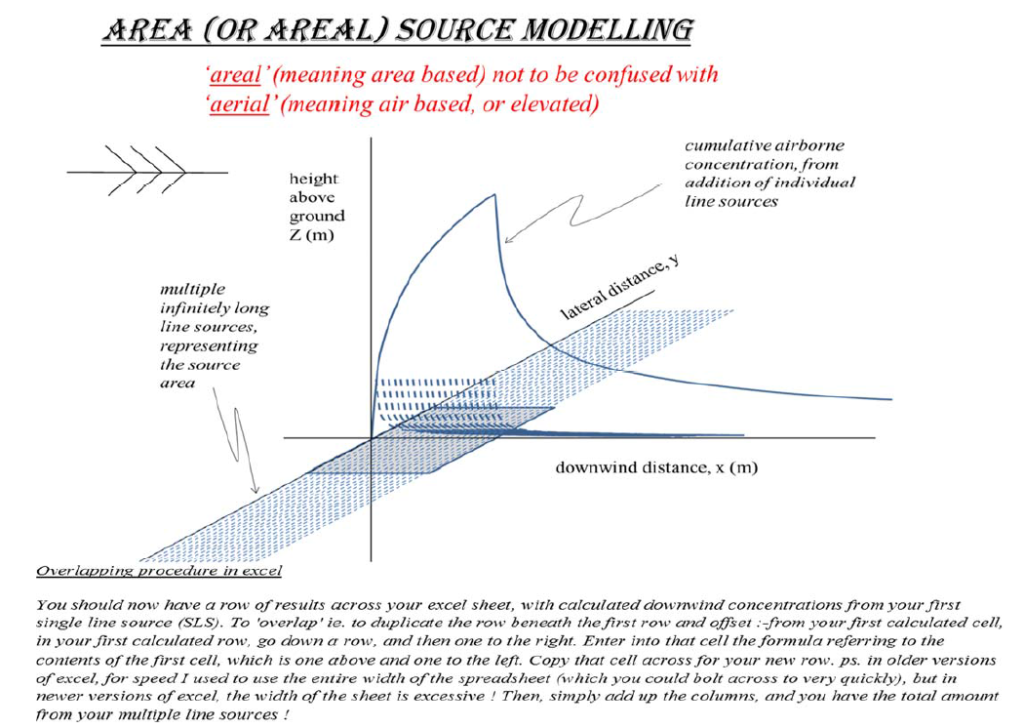Gaussian Dispersion Problem
Brief
If there is a wind, then ‘spraydrift’ (travel of pesticide downwind of the intended target area) is something
that always happens when crop spraying takes place, if some of the droplets in the liquid spray are less than
100μm in size and therefore considered ‘driftable’. For the purposes of this exercise, assume that one third
of the spray by volume applied to the cotton cropped area (depicted below) by the spray aircraft is composed
of droplets less than 100μm VMD (ie. Volume Median Diameter), and so this fraction of the spray
(sometimes referred to as ‘aerosol’) is assumed to be composed of droplets that are fully airborne (ie. nonsedimenting).
Assume that the aircraft flies numerous swaths across the cotton in a crosswind direction.
Assume that these swaths can be adequately modelled using the Gaussian Dispersion Line Source method.

Assume that the area of cotton to be sprayed is 1km in the downwind direction (ie. the direction parallel to
the wind). Assume that the wind direction is perpendicular to the upwind and downwind paddock
boundaries. Assume that the wind direction and speed do not vary. Assume that the windspeed is 3m/s.
Assume that the atmosphere has Pasquill class E stability. Assume that the swath width deployed by the
aircraft (ie. the distance between successive spray lines) is 25m. Assume that GPS is used, so that the
crosswind spray lines are perfectly parallel to one another
Task
You are required to set up an excel spreadsheet, to model what is happening here. Figure 2 below will give
you some guidance.

Figure 2 Some guidance as to how to set up spreadsheet model. Please use the Line Source Variant (LSV) of the Gaussian
Diffusion Model (GDM) described in your lectures. Use multiple line sources, assuming that these are infinitely long in the
crosswind direction. The swath width deployed by the aircraft is 25m, so you should be using 1000/25 or 40 lines. Once you
have set up your spray lines, you then have to calculate what the Line Source Strength must be, to meet the requirement of
1 litre aerosol released per hectare.
Requirement
Assume that Australian Export Beef Cattle Stock Feeding Route (SFR) runs all along the downwind border
of the cotton paddock. When cattle graze the long grass here, they are at risk of picking up a residue of the
pesticide. You are required to use you spreadsheet to calculate the required Spray Drift Buffer Distance in
metres. In other words, this is the downwind area which must remain unsprayed, so that cattle feeding along
the SFR do not pick up a residue exceeding the Maximum Residue Limit (MRL). Please express your
answer in terms of the width in metres, the downwind portion of the cotton paddock area which must remain
unsprayed. Assume that the cattle MRL level will be met, when the airborne aerosol concentration above the
SFR grass is 1/10th of that experienced above the paddock. For your spreadsheet modelling purposes, please
assume the following value for E, the rate of vapour emission from the paddock, post spray :-
0.1 g m-1 day-1, for a period exceeding 10 days
Submission Requirements
Submit two files (using Moodle Assignment Submission Area) as follows :-
1) Excel spreadsheet file (this will only be looked at briefly)
2) Written short report pdf (insert relevant graphs into your report, and describe what they
mean in the text. Use detailed numbered figure captions).
